
Language and Linguistics
Scope & Guideline
Bridging Theory and Practice in Linguistic Research
Introduction
Aims and Scopes
- Structural Analysis of Languages:
The journal consistently publishes papers that analyze the syntactic and morphological structures of various languages, particularly Mandarin, Tibetan, and other East Asian languages, contributing to the field of comparative linguistics. - Semantic and Pragmatic Studies:
A significant focus is placed on the semantics and pragmatics of language use, including the examination of modal expressions, evidentiality, and discourse markers, which enhances the understanding of meaning in context. - Historical Linguistics and Language Change:
Research on diachronic aspects, including the evolution of grammatical structures and phonological changes over time, is a core area, providing insights into the historical development of languages. - Typological and Comparative Linguistics:
The journal emphasizes typological studies that compare linguistic features across languages, particularly within the Sino-Tibetan language family and East Asian languages, fostering a deeper understanding of linguistic diversity. - Cultural and Contextual Language Use:
Papers often explore the intersection of language with culture, examining how linguistic practices are influenced by social and contextual factors, which is crucial for understanding language in its real-world applications.
Trending and Emerging
- Cross-Linguistic Pragmatics:
There is a growing interest in pragmatics across different languages, particularly in how contextual factors influence meaning and usage, which is crucial for understanding communication in multilingual contexts. - Cognitive Linguistics:
An emerging trend is the application of cognitive approaches to language, exploring how mental processes shape linguistic structures and usage, indicating a shift towards interdisciplinary research that connects linguistics with psychology. - Grammaticalization and Language Change:
Increased attention is being given to grammaticalization processes, particularly in how languages evolve over time, reflecting a broader interest in historical linguistics and the mechanisms of language change. - Empirical and Experimental Methods:
There is a noticeable rise in studies employing empirical and experimental methodologies, including corpus-based analyses and psycholinguistic experiments, which provide robust data to support theoretical claims. - Language and Identity:
Research exploring the relationship between language and identity, including how language reflects and constructs social identities, is gaining traction, emphasizing the socio-cultural dimensions of linguistic study.
Declining or Waning
- Traditional Grammar Frameworks:
Research grounded strictly in traditional grammatical frameworks appears to be declining, as newer studies increasingly adopt more dynamic and interdisciplinary approaches to understanding language. - Descriptive Studies of Less Common Languages:
Although some descriptive studies of less common languages were previously featured, there has been a noticeable reduction in such publications, possibly due to a shift towards more widely spoken languages and comparative analyses. - Phonetic and Phonological Detail Studies:
There has been a decrease in the number of papers focusing solely on detailed phonetic and phonological analyses without broader implications or connections to semantic or syntactic studies, indicating a trend towards integrative research. - Static Language Models:
Research that relies on static models of language without considering the dynamic and evolving nature of linguistic usage is becoming less frequent, as scholars increasingly recognize the importance of context and change.
Similar Journals
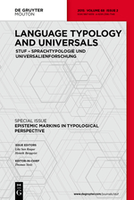
STUF-Language Typology and Universals
Discovering the Patterns that Shape Human LanguageSTUF-Language Typology and Universals, published by WALTER DE GRUYTER GMBH, is a renowned journal in the field of linguistics focusing on language typology and universals. With an ISSN of 1867-8319 and an E-ISSN of 2196-7148, this journal has established itself as a significant source of scholarly research, evidenced by its strong rankings, including a Q2 classification in the linguistics category for 2023. The journal aims to explore the rich diversity of languages while seeking to uncover the underlying principles that govern their structures and functions. Its interdisciplinary scope appeals to linguists, cognitive scientists, and social scientists alike, fostering a deeper understanding of language as a fundamental human capacity. Researchers and professionals are encouraged to contribute to this academic discourse, as it plays a vital role in advancing the field of language studies. With access options through various platforms, STUF continues to disseminate high-quality research and stimulate innovative thoughts within the linguistic community, making it an indispensable resource for scholars and students worldwide.

LINGUISTIQUE
Illuminating the Complexities of Linguistic TheoryLINGUISTIQUE, an esteemed journal published by PRESSES UNIV FRANCE, serves as a vital platform for scholarly discourse in the fields of linguistics and language studies. With its ISSN 0075-966X and E-ISSN 2101-0234, this French journal has been a significant contributor to the understanding of linguistic phenomena since its inception in 2004, and it continues its journey through to 2024. Although currently categorized in the Q4 quartile for both Arts and Humanities (miscellaneous) and Linguistics and Language, its commitment to publishing quality research encourages a diverse range of articles, reviews, and innovative studies. Positioned in the 32nd and 29th percentiles for its respective fields according to Scopus rankings, LINGUISTIQUE is dedicated to advancing knowledge and stimulating engagement among researchers, professionals, and students alike. While it does not offer open access, the journal remains an essential resource for those who seek to deepen their understanding of linguistic principles in a global context, facilitating a richer discourse that connects theory with practice.
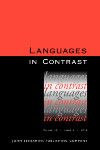
Languages in Contrast
Dissecting Language: A Journey into Contrast and ComparisonLanguages in Contrast, a distinguished journal published by John Benjamins Publishing Co, serves as a vital platform in the field of linguistics, particularly focusing on the comparative study of languages. Operating under the ISSN 1387-6759 and E-ISSN 1569-9897, this journal has established its significance, achieving a commendable Q2 ranking in the 2023 Linguistics and Language category, indicative of its strong impact and reputation within the scientific community. With a Scopus ranking of #294 out of 1167, positioning it in the 74th percentile of its field, it consistently publishes high-quality research that explores the nuances and contrasting features of various languages, fostering deeper understanding and knowledge sharing among researchers, professionals, and students alike. While the journal is not open access, its rigorous peer-review process ensures that the contributions it includes are both insightful and groundbreaking, making it an invaluable resource for anyone invested in the study of languages. With coverage extending from 2008 to 2024, Languages in Contrast is poised to continue its pivotal role in advancing linguistic research and scholarship.
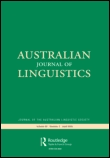
Australian Journal of Linguistics
Championing Quality Research in LinguisticsThe Australian Journal of Linguistics, published by Routledge Journals, Taylor & Francis Ltd, stands as a distinguished platform in the field of linguistics, fostering rigorous academic discourse since its inception in 1981. With an ISSN of 0726-8602 and an E-ISSN of 1469-2996, the journal has achieved a notable Q2 ranking in the linguistics and language category for 2023, indicating its quality and relevance within the academic community. With a Scopus ranking of #316 in Arts & Humanities and #373 in Social Sciences, it sits in the 71st and 68th percentiles respectively, underscoring its impact in the fields it encompasses. The journal aims to publish high-quality research articles that contribute to the understanding of linguistic theory, sociolinguistics, and applied linguistics, making it an essential resource for researchers, professionals, and students alike. The journal is based in the United Kingdom, at 2-4 Park Square, Milton Park, Abingdon OX14 4RN, Oxon, England, and actively encourages contributions that can expand the current linguistic discourse, reinforcing its commitment to highlighting diverse perspectives in language research.
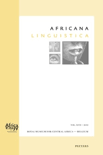
Africana Linguistica
Promoting Research on Africa's Linguistic DiversityAfricana Linguistica is a premier journal dedicated to the exploration and analysis of linguistic studies concerning African languages and their dialects. Published by PEETERS, a highly regarded academic publisher, this journal aims to promote scholarly discourse and research on the diverse linguistic landscapes of Africa. With its emphasis on both theoretical and applied linguistics, Africana Linguistica serves as a vital resource for researchers, professionals, and students alike, facilitating the dissemination of groundbreaking research and fostering greater understanding of African linguistic heritage.
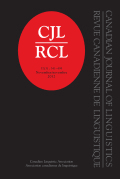
CANADIAN JOURNAL OF LINGUISTICS-REVUE CANADIENNE DE LINGUISTIQUE
Championing rigorous research and innovative theories in linguistics.The Canadian Journal of Linguistics - Revue canadienne de linguistique is a prestigious peer-reviewed publication dedicated to advancing the field of linguistics. Published by Cambridge University Press, this journal has firmly established itself as a vital resource for researchers, professionals, and students alike, offering insights into a diverse range of linguistic studies and theories. With an impressive impact factor reflecting its academic rigor, the journal is ranked Q2 in the categorization of linguistics and language as of 2023, and holds commendable positions in both Scopus ranks for Arts and Humanities as well as Social Sciences. The journal's converged years span from 1996 to 2024, showcasing a rich history of contributions to the discipline. Although it currently does not offer open access, it remains highly influential. Located in Canada, the journal plays a crucial role in fostering scholarly communication within the linguistic community, making it an essential outlet for disseminating groundbreaking research and engaging discussions.

Studia z Filologii Polskiej i Slowianskiej
Pioneering Research in Slavic Linguistic PhenomenaStudia z Filologii Polskiej i Slowianskiej is a prominent journal published by the Polish Academy of Sciences, Institute of Slavic Studies, focusing on the rich and diverse field of linguistics and language studies, particularly within the Slavic context. With the ISSN 0081-7090 and E-ISSN 2392-2435, this open-access journal has been a valuable resource for researchers, professionals, and students since its transition to an open-access model in 2014. It features rigorous peer-reviewed articles that contribute to the understanding of linguistic phenomena and cultural narratives across Slavic languages. Recognized within the Q3 quartile of linguistics and language in 2023, it ranks at the intersection of arts, humanities, and social sciences, providing insights that echo through disciplines such as sociolinguistics, psycholinguistics, and philology. In its ongoing publication trajectory from 2011 to 2023, Studia z Filologii Polskiej i Slowianskiej continues to foster academic discourse and collaboration, positioning itself as a key player in the global linguistic community.

Studi e Saggi Linguistici
Fostering Critical Dialogues in Language StudiesStudi e Saggi Linguistici is a distinguished academic journal published by EDIZIONI ETS, based in Pisa, Italy. With its ISSN 0085-6827, this journal has established itself as a vital resource in the field of linguistics, particularly noted for its contributions since its inception in 2016. Although currently categorized in the lower quartile (Q4) by the 2023 metrics in the domains of Linguistics and Language within Scopus, it remains a significant platform for innovative research and critical discussions surrounding language studies. Focusing on both theoretical and practical aspects of linguistics, the journal serves as a nexus for scholars and practitioners alike, facilitating a rich interchange of ideas and knowledge in a rapidly evolving discipline. As an invaluable publication for researchers, professionals, and students, Studi e Saggi Linguistici is committed to advancing the understanding of linguistic phenomena and fostering scholarly communication in its field.

Mandenkan-Bulletin Semestriel d Etudes Linguistiques Mande
Unveiling Insights into Mande Language StudiesMandenkan-Bulletin Semestriel d'Etudes Linguistiques Mande is an esteemed academic journal dedicated to the exploration of Mande languages and linguistics, published by the Centre National de Recherche Scientifique in France. With its ISSN 0752-5443, this journal has established itself within the linguistic community, holding a notable Q3 ranking in both the Linguistics and Language category as well as respectable standings in Scopus ranks, placing it in the 55th percentile for language and linguistics. Since its inception in 2018, it has been pivotal in publishing groundbreaking research that advances our understanding of the Mande language family and its cultural implications. Although currently not open access, the journal offers a wealth of knowledge fostered through rigorous peer-reviewed articles aimed at linguists, researchers, and students alike, making significant contributions to the fields of linguistics and African studies.

Journal of Slavic Linguistics
Unlocking the Nuances of Slavic SpeechJournal of Slavic Linguistics, published by SLAVICA PUBLISHERS, is a key academic resource dedicated to the exploration of Slavic languages and linguistics. Established to provide a comprehensive platform for scholarly research, this journal addresses the intricate dynamics of Slavic phonetics, syntax, semantics, and discourse, making significant contributions to both theoretical and applied linguistics. The journal holds an impact factor that reflects its value in the linguistic community, particularly as it is ranked in the Q4 category in Linguistics and Language for 2023. With a focus on a wide range of topics within the field, the Journal of Slavic Linguistics serves as an essential reference for researchers, educators, and students alike, fostering an appreciation and deeper understanding of Slavic linguistic phenomena. Although currently not an Open Access journal, it remains accessible to a broad audience keen on engaging with contemporary linguistic scholarship.